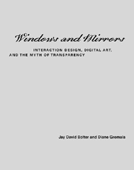


Italian version
 . book
. bookJay David Bolter, Diane Gromala
Windows and Mirrors : Interaction Design, Digital Art, and the Myth of Transparency
<book> The MIT Press
ISBN 0262025450
Explaining the fanciful title of this essay, the authors state that "any digital artifact is half transparent and half reflective", alternating between these two states according to the interface. The close correlation and, at the same time, the big difference between digital design and digital art flows in the analysis of the works presented, borrowed from the Siggraph 2000 Art Gallery. The analysis unravels between the necessary interaction with the user, the invisibility of the interface and its illusionary power, and the dangers and errors implied by its credibility. This borderline territory touches the most experimental facets of design and, on the other hand, the most functional aspects of art. This is precisely one of the key points of this text, apparently aimed more at convincing designers of the profitability of the conceptual nature of art than at consolidating their strategical role in the communication world, compared to the more functional approach adopted by technicians. Every analysis is completed by a historical part on computer science as medium or media tool. This opens new paths of thought, but without succeding in leaving behind the usual categories of design, which remain as omnipresent guidelines. The most visionary design has expressed, in time, ideas and products which, as abstractions of strong concepts, had the same dignity of the works of art exhibited in museums. But the price the authors had to pay to reach that level was to widen their horizons to include practices, technologies and concepts which didn't strictly belong to design, overcoming barriers which, sooner or later, systematically rear their head. If this book contributes to anything, it does it by demonstrating once again the need for an enlightened interdisciplinarity which, instead of putting the different schools of thought one against the other, values the best ideas and their intrinsic, and sometimes revolutionary, potential.